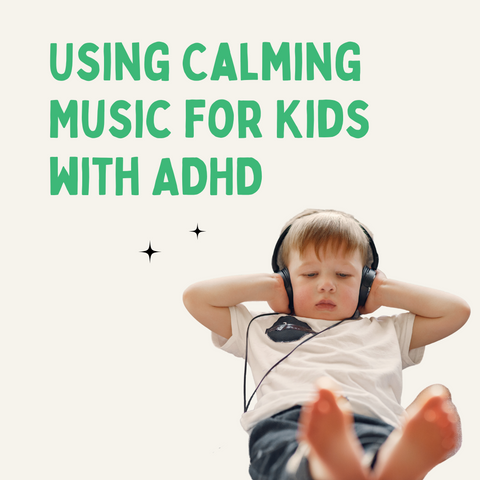
Using Calming Music for Kids with ADHD
Disclaimer: The information provided in this article is for general informational purposes only and should not be considered as medical, psychological, or educational advice. The use of calming music for kids with ADHD should be discussed with a qualified healthcare professional.
The authors and publishers of this article do not assume any responsibility or liability for any consequences arising from its use. Individualised treatment plans and professional guidance are essential for managing ADHD.
Attention Deficit Hyperactivity Disorder (ADHD) is a common neurodevelopmental disorder that affects children, making it difficult for them to focus, control impulses, and manage their emotions.
For many parents and educators, finding effective strategies to help children with ADHD can be challenging. 
One promising approach is using calming music to create a soothing environment and reduce the symptoms of ADHD.
In this article, we'll explore the benefits of calming music, how to select the right music, and practical ways to incorporate it into a child's daily routine.
Benefits of Calming Music
Improved Focus
Research shows that calming music can help children with ADHD maintain focus and attention.
By providing a non-distracting background noise, music can help drown out external distractions and make it easier for kids to concentrate on tasks at hand.
Reduced Anxiety
ADHD can cause feelings of anxiety, restlessness, and stress.
Calming music can help to alleviate these symptoms by promoting relaxation and a sense of calm, allowing children to feel more at ease in their environment.
Improved Emotional Regulation
Children with ADHD often struggle with emotional regulation. Calming music can provide a soothing backdrop that helps them process and manage their emotions more effectively.
Better Sleep
Sleep problems are common among children with ADHD. Calming music played at bedtime can help create a relaxing atmosphere, making it easier for kids to fall asleep and stay asleep throughout the night.
Selecting Calming Music
Instrumental Music
Choose instrumental music without lyrics, as words can be distracting for children with ADHD. Opt for genres like ambient, new age, or world music, which are known for their calming qualities.
Nature Sounds
Nature sounds, such as rain, ocean waves, or bird songs, can be incredibly soothing for children with ADHD.
These sounds can help create a sense of tranquillity and promote relaxation.
Classical Music
Classical music, especially the works of composers like Mozart, Bach, or Beethoven, can have a calming effect on children with ADHD. Select pieces with slow tempos and gentle melodies.
Binaural Beats
Binaural beats are a type of auditory illusion that can induce a relaxed state of mind.
Consider incorporating binaural beats into your child's calming music playlist.
Creating a Music Routine
Bedtime Routine
Incorporate calming music into your child's bedtime routine to help them relax and prepare for sleep.
Start the music about 30 minutes before bedtime and gradually lower the volume as they drift off to sleep.
Homework Time
Play calming music during homework time to create a focused and serene environment.
Choose instrumental music or nature sounds that will not distract your child from their work.
Quiet Time
Set aside a designated quiet time each day, during which your child can listen to calming music and engage in a calming activity, such as reading, drawing, or meditation.
This can help them develop self-regulation skills and manage ADHD symptoms.
Transition Times
Use calming music during transition times, such as moving from one activity to another or returning home from school.
This can help to reduce stress and anxiety and make transitions smoother for children with ADHD.
Using Music in the Classroom
Background Music
Teachers can play calming music in the background during independent work or group activities to help create a more focused and relaxed atmosphere for students with ADHD.
Break Time
Incorporate calming music into break times or relaxation periods in the classroom.
This can help students with ADHD to recharge and refocus before resuming their work.
Structured Listening
Introduce structured listening activities that incorporate calming music.
These can help students with ADHD develop active listening skills and improve their focus and attention.
Music Therapy
Consider implementing a music therapy programme for students with ADHD.
Music therapists are trained professionals who use music interventions to address various emotional, cognitive, and behavioural issues.
In Summary
Calming music can be a powerful tool for children with ADHD, helping to improve focus, reduce anxiety, and promote emotional regulation.
By carefully selecting the right music and incorporating it into daily routines and the classroom environment, parents and educators can create a more supportive and calming atmosphere for children with ADHD to thrive.
FAQs
Is there a specific type of music that works best for all children with ADHD?
There isn't a one-size-fits-all answer, as individual preferences vary. Experiment with different types of calming music, such as instrumental, nature sounds, classical music, and binaural beats, to find what works best for your child.
Can I use calming music to help my child with ADHD during their therapy sessions?
Yes, you can consult with your child's therapist about incorporating calming music into their therapy sessions to enhance the overall experience and help them relax.
How loud should the calming music be when played for a child with ADHD?
The volume should be set at a comfortable level that is not distracting or overstimulating. Experiment with different volume levels to find the optimal setting for your child.
Can I use calming music as a reward system for my child with ADHD?
Yes, you can use calming music as a reward for positive behaviour or for completing tasks. This can help reinforce good habits and motivate your child.
Are there any potential negative effects of using calming music for children with ADHD?
As long as the music is not too loud or overstimulating, there should be minimal negative effects. However, it's essential to monitor your child's response and adjust the music selection and volume accordingly.
